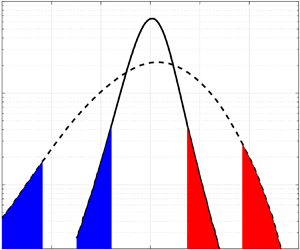No CrossRef data available.
Published online by Cambridge University Press: 14 November 2024

This study investigates the correlation between the fluctuating wall heat flux, and the distribution and transport of Reynolds shear stress and turbulent heat flux in compressible boundary layers at Mach number 5.86 and friction Reynolds number 420, with a relatively weaker and a stronger wall cooling imposed. As illustrated from the probability density functions of the wall-heat-flux perturbations, with increasing wall cooling, the extreme wall heat flux is intensified and tends to be more negatively skewed. To examine the role of the extreme events in the transport of the momentum and heat, conditional analysis of the extreme positive and negative wall-heat-flux-perturbation events is conducted. In most regions of the boundary layer, the positive events are predominantly associated with an increase in Reynolds shear stress and a decrease in turbulent heat flux. Joint probability density functions of velocity and wall-heat-flux perturbations in the near-wall region indicate that the extreme positive events tend to be more correlated with ejections, which is particularly evident in the stronger wall-cooling case. To further shed light on the underlying mechanisms of the connections between wall heat flux and transport budgets, a transport equation for turbulent heat flux is derived, in a similar manner to that for Reynolds shear stress. The energy balance is inspected, with conditional analysis applied to budget terms and mean flow properties so as to quantify the correlation between wall-heat-flux fluctuations and energy evolution.